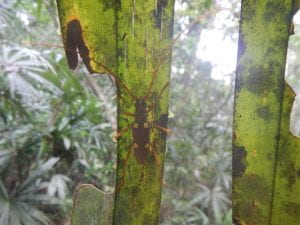May 16, 2019
Today was our first full day at Las Cuevas Research Station, and we actually got to explore the trails here, as we set up seven camera traps (cameras strapped to trees that take photos when motion is detected – we’ll be checking the photos on our last day here). The crazy overgrown trails of the Chiquibul revealed some pretty interesting finds, including a group of curious spider monkeys and several blue morphos!
The sightings that really interested me (of course) were the beetles, my assigned taxon. Some of the more flashy beetles included a metallic wood-boring beetle (likely from the genus Euchroma) with a blue-green metallic body, as well as a large black beetle with a distinct red outline around its thorax and abdomen and vertical ridges along its abdomen only.
But there’s nothing like the feeling of finding a beetle that exactly matches a species from your taxon ID card, and I’m talking not just the kind of beetle, but also its exact position and proportions. This beetle was (drumroll please) Eburia pedestris, a longhorn beetle with four symmetrical yellow spots and long orange antennae and legs.
And believe it or not, all this was worth the ticks! After our hike, we spent around 30 minutes laboriously checking for and removing ticks. Many of us had to stop knowing the unfortunate truth that we may have missed one.

